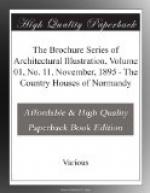LXXXV.
Manoir de Vitanval, Ste. Andresse, Normandy.
Ste. Andresse is a small community on the coast of Normandy a few miles north-west of Havre.
LXXXVI to LXXXVIII.
Manoir D’ANGO, Normandy.
This manoir has already been referred to in the preceding number, where four other views are given.
Architectural Schools.
Columbia college.
In the series of articles in which we have undertaken to give an idea of the scope of the courses of architectural study offered by the various schools of the country, we can hardly do better, in referring to Columbia College, than quote from a paper in which Professor William R. Ware describes the methods used for the teaching of the history of architecture at Columbia. Our extracts are made from a portion of the paper printed in The American Architect for November 30, 1895.
These four exercises, the Lectures on History and Ornament, with the study of English, French, and German text-books, the Historical Research, the Historical Drawing, and the Historical Design, occupy a chief part of the student’s time during the first three years of the course. At the end of the third year the stated instruction by recitations and the lectures is virtually finished, the fourth year being, by an arrangement which is perhaps a novelty in places of learning, quite free from lectures or recitations. The men give their whole time by day to problems in design, to what may be called “atelier work,” without interruption. Their evenings, throughout the whole year, are devoted to historical study. As the college library, including the Avery library, as well as the books and photographs belonging to the Department of Architecture, is accessible every evening until eleven o’clock, and the Metropolitan Museum is open twice a week until ten, every facility is afforded for the prosecution of this work. In order to make the most of these appliances, every student of the Fourth-year class and all the special students (who are of similar grade, being received only in advanced standing) prepares once a month, under the name of Advanced Architectural History, an original paper. This he illustrates by drawings and reads to the class. All this affords an almost unexampled opportunity for serious work.
We exhibit to the students the architecture of the past as a series of problems just as it appeared to the builders of its own day, and we hope thus not only to give them a clearer insight into the real spirit and character of the masterpieces that have come down to us, by bringing to view the ideas and considerations which really influenced their designers, but at the same time to exercise our own young men in the practical application of those same ideas. We hope thus to develop in them the same good sense and good taste, the same readiness of invention and happy ingenuity, to which these masterpieces are due.




